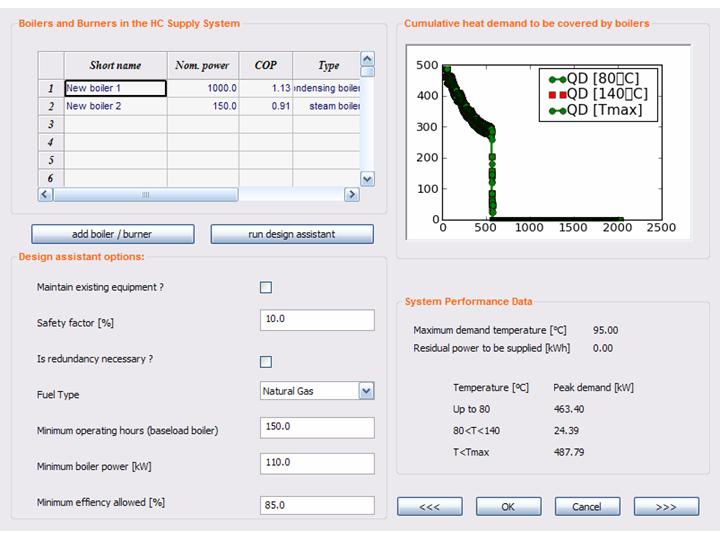6.8.6. Boilers and Burners¶
The ‘Boilers & burners’ window can be subdivided in four funtional areas.

The boiler & burner design assistant window
6.8.6.1. Overview of Existing Equipment¶
In the first quadrant (top-left) all the boilers of the current alternative are displayed by ‘cascade index’. When opening the window this index corresponds to the order in which the equipments have been filled in the questionnaire; it can be changed manually in the ‘H&C Supply’ window or automatically by running the design assistant. Besides the name of the equipment some additional information such as nominal power, efficiency and year of manufacturing are given.
6.8.6.2. Graphical Representation of Demand and Supply¶
In the second quadrant (top-right) there is a graphic showing the heat demand to be supplied by boilers. Three curves are displayed each one representing a different temperature level. The lower one is the heat demand at a temperature till to 80°C, the second one is the demand at temperature lower than 140°C while the higher curve is the total heat demand. These are all cumulative curves and it means that the demand at a higher temperature is necessary bigger than a lower temperature one. Moreover each curve is ordered by decreasing power and therefore it represents the demand to be supplied for that number of hours, and not the demand at a given hour.
6.8.6.3. Configuration of Design Assistant¶
In the third quadrant (bottom-left) the user can modify some parameters for the configuration of the ‘design assistant’ function. In particular the parameters are:
- Maintain existing equipment? (default value: yes): if no the design assistant deletes all the boiler from the equipment list and design a new set of boiler to supply the demand.
- Safety factor[%] (default value: 10): the peak demand should be raised by a safety factor to consider the uncertainty of measurements and the possible increase of the demand through time
- Is redundancy necessary? (default value: no): allows to specify whether the enterprise can accept a reduced heat supply capacity when a boiler is off (for ordinary or extraordinary maintenance) or not.
- Fuel type (default value: natural gas): some industries are not reached by the natural gas distribution net
- Minimum operating hours (baseload boilers) (default value: 2000)
- Minimum boiler power [kW] (default value: 100)
- Minimum efficiency allowed [%] (default value: 80): the design assistant automatically deletes the low efficiency boilers from the equipments list.
Some of these parameters can be modified only in the interactive mode.
6.8.6.4. Relevant Parameters of Heat Demand¶
In the fourth quadrant (bottom-right) some additional information such as the residual peak demand to be supplied (i.e. the demand the actual alternative is cannot supply) are collected in order to help the user in his/her design process.
6.8.6.5. How to design the boiler system ?¶
This tool gives the possibility to add/delete boilers to/from the equipment list manually or to run a design assistant.
- The user can delete a boiler by right clicking on it. A pop-up requests to confirm the choice and then cancellation will be effective. Einstein automatically updates the boiler list and the residual peak demand to be supplied.

The add boiler/burner pop-up
- Clicking on the ‘add boiler/burner’ button a pop-up will request the user to specify “where” to find the new boiler. The user has three possibilities: 1) to select the equipment from the boiler database; 2) to enter the boiler data manually; 3) to retrieve it from a list of previously deleted boilers.
- If the user clicks the ‘run design assistant’ button Einstein will work for him/her! Indeed the design assistant is able to analyse the heat demand and to find a suitable set of boiler to supply it efficiently. Moreover the assistant deletes inefficient boilers and modify-if necessary- the cascade index ordering them by increasing temperatures and decreasing efficiency levels. Before running it, the user can change some of the design assistant parameters (see above).
The user can accept the boiler set configuration by clicking the ‘ok’ button.